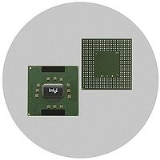
Pentium M
Overview
The Pentium M brand refers to a family of mobile single-core x86 microprocessor
Microprocessor
A microprocessor incorporates the functions of a computer's central processing unit on a single integrated circuit, or at most a few integrated circuits. It is a multipurpose, programmable device that accepts digital data as input, processes it according to instructions stored in its memory, and...
s (with the modified Intel P6 microarchitecture
P6 (microarchitecture)
The P6 microarchitecture is the sixth generation Intel x86 microarchitecture, implemented by the Pentium Pro microprocessor that was introduced in November 1995. It is sometimes referred to as i686. It was succeeded by the NetBurst microarchitecture in 2000, but eventually revived in the Pentium M...
) introduced in March 2003 (during the heyday of the Pentium 4
Pentium 4
Pentium 4 was a line of single-core desktop and laptop central processing units , introduced by Intel on November 20, 2000 and shipped through August 8, 2008. They had a 7th-generation x86 microarchitecture, called NetBurst, which was the company's first all-new design since the introduction of the...
desktop CPUs), and forming a part of the Intel Carmel notebook platform under the then new Centrino
Centrino
The Centrino brand represents Intel Wi-Fi and WiMAX adapters. It was formerly a platform-marketing initiative from Intel until January 7, 2010....
brand. The Pentium M processors had a maximum thermal design power
Thermal Design Power
The thermal design power , sometimes called thermal design point, refers to the maximum amount of power the cooling system in a computer is required to dissipate. For example, a laptop's CPU cooling system may be designed for a 20 watt TDP, which means that it can dissipate up to 20 watts of heat...
(TDP) of 5–27 W depending on the model, and were intended for use in laptops (thus the "M" suffix standing for mobile).

